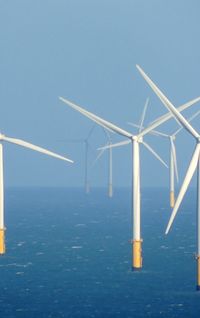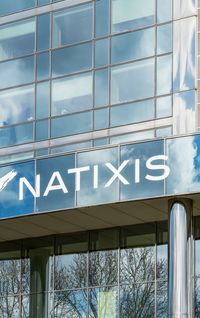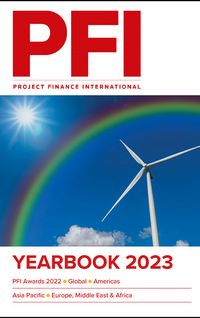Unlocking the North Sea's potential as a clean energy hub and co-ordinating electricity transmission from its offshore generation assets will be key to meeting net-zero targets writes Bryony Theaker, a senior associate in Clifford Chance's energy and infrastructure team.
Historically, the North Sea's rich oil and gas fields have been a cornerstone of bordering countries' energy policies. As the UK and its near neighbours seek to meet their ambitious climate goals and reduce their dependence on Russian fossil fuels, it is now the abundant supply of renewable energy in the North Sea that forms a central part of their clean energy strategies.
The UK and EU are targeting a rapid expansion of offshore wind capacity in the North Sea. In order to maximise the potential of such offshore wind resources, an increased focus on offshore co-ordination of energy transmission from North Sea generation assets and rationalisation of the connection framework will be vital.
With this in mind, a number of European countries are planning to build energy islands in the North Sea to act as hubs for the generation of clean energy. These energy islands would centralise the generation of renewable energy on an existing or artificial island and transmit such electricity via high voltage direct current (HVDC) subsea cable to the grids of connected countries.
Currently, offshore wind farms connect directly to their home grids in a point-to-point formation and standalone interconnectors transport electricity between connected countries. It is increasingly clear that such point-to-point transmission connections will not be an efficient mechanism for expansion of offshore renewable generation in the magnitude required. It is expected that energy islands will transmit electricity to the grids of connected countries using multi-purpose interconnectors (MPIs) or hybrid schemes, which are transmission assets combining the transmission of electricity generated by and direct connection to offshore windfarms with cross-border interconnection. By merging such functions and allowing transmission from generating asset hubs as well as between interconnected electricity markets, significant synergies can be achieved.
* Use of MPIs will reduce the number of landfall points required for grid connection, which will minimise disruption for communities settled on the coast and lower the overall planning and land rights burden for developers.
* MPIs enable transmission infrastructure to be used more efficiently. There is often significant unused capacity in offshore wind transmission cables, typically about 50%, as the cable is sized to match the maximum capacity of the offshore wind farm, while the offshore wind farm's load factor is reduced when conditions are not windy. MPIs can allow this excess capacity to be used to trade power between markets in nearby countries, thereby allowing efficient use of the infrastructure.
* Such efficiencies have a cost benefit, as there is an overall reduction in the amount of cable required, when compared with a point-to-point connection scheme. In the current market, where HVDC cable costs are high and there is a shortage of manufacturing slots, this offers significant advantages.
* There are also environmental benefits associated with a reduction in the amount of cable manufactured and laid upon the seabed. A co-ordinated approach that combines and rationalises transmission assets and grid connections will be important to minimise the impact of such large-scale expansion of offshore wind development.
Countries seeking to benefit from such economies of scale include Denmark, Belgium, Germany and the Netherlands, which this year re-affirmed their commitment to developing the North Sea into "The Green Power Plant of Europe" in a joint declaration.
Belgium is developing what it believes will be the world's first offshore energy island in its Princess Elisabeth Zone. The island will be located 45km from the Belgian coastline and will host 3.5GW of additional renewable generation produced by Belgium's second-generation offshore wind farms. The energy island is being developed by the Belgian transmission systems operator (TSO), Elia, and will be constructed in modules, to facilitate further extension over time. The project will combine wind generation with interconnection to Denmark and also to the UK via the proposed Nautilus MPI. Elia envisages this energy island as the first building block in a European offshore electricity grid.
In Denmark, there are multiple projects afoot. The Bornholm Energy Island proposal in the Baltic Sea has been expanded to 3GW of offshore wind power, to be connected with the German and Danish electrical grids and developed jointly with Germany. The VindO Energy Island in the North Sea will initially connect 3GW and later up to 10GW of offshore wind generation and host interconnection to multiple countries.
There are also plans to build a hydrogen island on the Danish part of the Dogger Bank sandbank, which will use power generated by offshore wind resources to produce green hydrogen that can be exported via pipelines to neighbouring countries. When operating at full 10MW capacity in 2030 it is proposed that the island will be capable of producing 1 million tonnes of green hydrogen.
TSOs from Denmark, Germany and the Netherlands are collaborating on the North Sea Wind Power Hub, which was awarded Project of Common Interest Status by the European Commission in 2019. The North Sea Wind Power Hub will consist of one or more hubs in the north-east corner of Dogger Bank, initially connecting up to 12GW of offshore wind with the Danish, German and Dutch electricity grids in a "hub and spoke" formation. There are also plans for the co-location of electrolysis plants for green hydrogen production, in order to use the excess electrical power generated by wind farms at times when the wind is strong or there is low demand. Such efficient use of infrastructure is expected to go some way towards mitigating the conversion losses involved in green hydrogen production.
Within the UK, there are proposals for MPIs to connect the British grid to proposed Belgian and Danish energy islands, but no concrete plans to develop an energy island of its own in the near term. Following the UK's withdrawal from the EU, it is no longer a member of the North Seas Energy Cooperation (NSEC), which exists to support the development of offshore grid infrastructure and renewable energy in the North Sea. However, after the Russian invasion of Ukraine and the renewed focus on strengthening energy security in Europe that followed, it was announced in September 2022 that the UK is finalising a memorandum of understanding with the NSEC in order to increase cooperation in this area.
The development of these exciting energy island projects is not without considerable challenges. Such projects are exceedingly complex, requiring collaboration from a multitude of different stakeholders. While interconnector developers will be familiar with managing the interests of governments, TSOs and regulatory bodies in two connected jurisdictions, the development of MPIs on energy islands connecting additional jurisdictions will multiply the number of relevant parties, and also require the interests of wind investors and power utilities to be taken into account.
The regulatory frameworks required to bring such projects to fruition are still under development. At EU level there is no specific legal or regulatory framework addressing the specificities of MPIs. Nevertheless, both the European Commission and ENTSO-E have highlighted the benefits of MPI projects. The NSEC has committed to supporting the European Commission and strengthening cooperation in this area in order to achieve a fair distribution of costs and resources between the various market actors. While the benefits of MPI projects and energy islands might make sense on a pan-European level, care must be taken to ensure that all necessary parties are appropriately incentivised, and that sufficient thought is given to the interaction between various governmental incentive schemes for generators and operators of storage and transmission assets.
Within the UK and the EU, ownership unbundling arrangements operate to prevent ownership of control of connected generation and transmission assets. This may not be an insurmountable barrier to development of MPIs in the near term, however, the separation of ownership adds complexity to the management of risks during construction and development, and could potentially limit the number of parties that can invest in MPI projects.
Clarification on the electricity market arrangements applicable to MPIs will also be needed. In particular, whether the offshore wind farm connecting to the MPI is considered to be part of its home market and generation priced on the same basis as electricity in its home bidding zone, or whether a separate bidding zone is introduced for the connected offshore wind farms – and the electricity price set at the level of the connected zone where transmission capacity is available – ie, if the home market is importing, the price of the zone exporting to that market. Although the development of the separate offshore bidding zone model has advantages, particularly in respect to addressing EU requirements that a minimum of 70% interconnection capacity be available for cross-border trade, there are concerns regarding how quickly the regime can be readied for MPIs and further work is needed to harmonise markets.
In the UK, Ofgem is running a pilot for MPI applications this year with a cap and floor regime. The pilot will allow MPI developers to benefit from a bespoke assessment process, distinct from the assessment of point-to-point interconnectors, but with a re-opener that will allow the MPI developer to re-join the regular application window to the extent that the project would not be successful as an MPI but still has merits as a point-to-point interconnector.
Ofgem has confirmed that it is open to what it calls "non-standard interconnector-led" projects, ie, those combining offshore transmission with generation outside the UK, while noting that the policy and legal framework for this is still under development. There will be a maximum of three multi-purpose interconnector projects selected to go forward to the IPA stage in the pilot. This will enable Ofgem to focus on developing a regime that will benefit future projects and consider complex issues associated with multi-purpose interconnectors alongside specific cases.
The Ofgem pilot is a welcome step towards facilitating these innovative projects, which have the potential to improve and expand the transmission network in order to link an increasing number of offshore renewable projects in a cost-effective and efficient manner. Although there remain a number of regulatory challenges, there now appears to be clear political appetite to grapple with these issues, in order to meet the scale of the task ahead of us on the route to net zero.
The introduction of MPIs could represent the first step in the development of a meshed offshore grid to fully integrate the rapid build-out of offshore wind in the North Sea and transmit electricity to where it is needed most. Coupled with co-located hydrogen production and battery storage on energy islands, such projects can also provide the flexibility that is essential to decarbonised power systems. There remains work to be done, but a pathway is emerging for the North Sea to indeed become the green power plant of Europe.
To see the digital version of this report, please click here
To purchase printed copies or a PDF of this report, please email leonie.welss@lseg.com

















